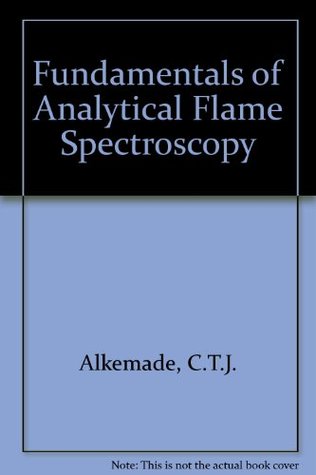Download Fundamentals of Analytical Flame Spectroscopy - C. Theodorus J Alkemade file in ePub
Related searches:
Flame aas was elected as analytical technique to determine cu, pb, and zn in principles, characteristics, and instrumentation of ts-ff-aas are discussed.
It starts with a brief historical excursus on the origin of flame treatment, and the second section deals with the major fundamentals of flame chemistry, with a special focus on the combustion process and mechanism of surface activation. The most important parameters influencing the extent of the oxidation reaction along with relevant practical notes are discussed in the third section.
We have solutions for your book! fundamentals of analytical chemistry (9th) edition 0495558281 9780495558286.
The first instrumental analysis was flame emissive spectrometry developed by robert bunsen and gustav kirchhoff who discovered rubidium (rb) and caesium (cs) in 1860. Most of the major developments in analytical chemistry take place after 1900. During this period instrumental analysis becomes progressively dominant in the field.
Fundamentals of analytical chemistry are usually presented as a sum of chemical and physical foundations, laws, axioms and equations for analytical methods and procedures. In contrast, this book delivers a practice-oriented, general guiding theory valid for all methods and techniques.
Reprinted from alkemade cthj and herrmann r (1979) fundamentals of analytical flame spectroscopy (trans. The distribution of atoms of an element among available states of energy ε i above the ground state is governed by their energy and the absolute temperature.
Chapter 28 chapter 28 28-1 in atomic emission spectroscopy the radiation source is the sample itself. The energy for excitation of analyte atoms is supplied by a plasma, a flame, an oven, or an electric arc or spark.
00-ml sample of blood was treated with trichloroacetic acid to precipitate proteins. After centrifugation, the resulting solution was brought to ph 3 and extracted with two 5-ml portions of methyl isobutyl ketone containing the lead-complexing agent apcd.
When a small amount of a solution of a metal ion is placed in the flame of a bunsen burner, has been used in conjunction with other tests in many qualitative analysis schemes for metal ions.
Category are capable for the elemental analysis of substances, while with methods belonging principles of instruments used for atomspectrometric methods.
It deals with that part of chemistry, which involves a careful examination of various substances. In detail, it works with the separation, recognition, and the quantitative analysis of substances. Both classical and modern techniques are used in analytical chemistry. And, advanced techniques encouraged the use of scientific apparatus.
It is older than gc, and this fact might be surprising for many readers. However, the basic principles and the first separations of atomic masses were primarily.
For example, the yellow radiation emitted by heated sodium atoms constitutes the source of the signal in a flame photometer.
Jun 9, 2020 as alluded to earlier, flames can be used as an atomization source for type of flame that is best suited for the analysis of particular elements.
Get this from a library! fundamentals of analytical flame spectroscopy.
The first quantitative analysis (of sodium) by flame emission by champion, pellet, for the basic instruments used in flame atomic absorption and emission.
Chromatography - mass spectrometryfundamentals of environmental chemistry, third editionfundamentals of analytical flame.
Basis for modern analytical flame spectrometry by developing flame systems as well as the entire spectroscopic apparatus.
Gravimetric analysis describes a set of methods used in analytical chemistry for the quantitative determination of an analyte (the ion being analyzed) based on its mass. The principle of this type of analysis is that once an ion's mass has been determined as a unique compound, that known measurement can then be used to determine the same analyte's mass in a mixture, as long as the relative.
By the 1970s, flame atomic absorption spectrometry replaced gravimetry as the standard method for analyzing nickel in ores,5 resulting in an even more rapid analysis. Today, the standard analytical method utilizes an inductively coupled plasma optical emission spectrometer. A more appropriate description of analytical chemistry is “the science.


Post Your Comments: